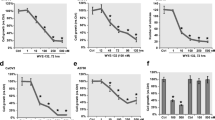Abstract
Purpose
Transforming growth factor-β-activating kinase 1 (TAK1) has been implicated in promoting ovarian cancer progression. Here, we evaluated the anti-ovarian cancer effect of LYTAK1, a novel and specific TAK1 inhibitor.
Methods
Established or primary human ovarian cancer cells were treated with LYTAK1, and its cytotoxicity and underlying mechanisms were analyzed using in vitro and in vivo assays.
Results
We demonstrated that LYTAK1 blocked TAK1-nuclear factor kappa B activation, and potently inhibited growth of established (SKOV3, CaOV3 and A2780 lines) or primary (patient-derived) human ovarian cancer cells, where TAK1 was over-expressed and over-activated. While the normal ovarian epithelial cells (IOSE-80), with low TAK1 expression, were minimally affected by the same LYTAK1 treatment. In ovarian cancer cells, LYTAK1 mainly induced necrosis (but not apoptosis), which was associated with mitochondrial permeability transition pore (mPTP) opening, the latter was evidenced by mitochondrial membrane potential reduction. Inhibition of mPTP, either by its inhibitor sanglifehrin A or cyclosporine A, as well as by siRNA-mediated knockdown of cyclophilin-D or voltage-dependent anion channel, attenuated LYTAK1-induced necrosis and cytotoxicity in ovarian cancer cells. In vivo, LYTAK1 oral administration suppressed growth of SKOV3 xenografts in nude mice, and its activity could be further enhanced by co-treatment of paclitaxel (Taxol).
Conclusions
These data reveal the therapeutic potential of LYTAK1 as an agent targeting the pro-oncogenic TAK1 in ovarian cancer.




Similar content being viewed by others
References
Siegel R, Ma J, Zou Z, Jemal A (2014) Cancer statistics, 2014. CA Cancer J Clin 64(1):9–29
Kipps E, Tan DS, Kaye SB (2013) Meeting the challenge of ascites in ovarian cancer: new avenues for therapy and research. Nat Rev Cancer 13(4):273–282
Vaughan S, Coward JI, Bast RC Jr, Berchuck A, Berek JS, Brenton JD, Coukos G, Crum CC, Drapkin R, Etemadmoghadam D, Friedlander M, Gabra H, Kaye SB, Lord CJ, Lengyel E, Levine DA, McNeish IA, Menon U, Mills GB, Nephew KP, Oza AM, Sood AK, Stronach EA, Walczak H, Bowtell DD, Balkwill FR (2011) Rethinking ovarian cancer: recommendations for improving outcomes. Nat Rev Cancer 11(10):719–725
Sakurai H (2012) Targeting of TAK1 in inflammatory disorders and cancer. Trends Pharmacol Sci 33(10):522–530
Martin SE, Wu ZH, Gehlhaus K, Jones TL, Zhang YW, Guha R, Miyamoto S, Pommier Y, Caplen NJ (2011) RNAi screening identifies TAK1 as a potential target for the enhanced efficacy of topoisomerase inhibitors. Curr Cancer Drug Targets 11(8):976–986
Melisi D, Xia Q, Paradiso G, Ling J, Moccia T, Carbone C, Budillon A, Abbruzzese JL, Chiao PJ (2011) Modulation of pancreatic cancer chemoresistance by inhibition of TAK1. J Natl Cancer Inst 103(15):1190–1204
Singh A, Sweeney MF, Yu M, Burger A, Greninger P, Benes C, Haber DA, Settleman J (2012) TAK1 inhibition promotes apoptosis in KRAS-dependent colon cancers. Cell 148(4):639–650
Ray DM, Myers PH, Painter JT, Hoenerhoff MJ, Olden K, Roberts JD (2012) Inhibition of transforming growth factor-beta-activated kinase-1 blocks cancer cell adhesion, invasion, and metastasis. Br J Cancer 107(1):129–136
Cai PC, Shi L, Liu VW, Tang HW, Liu IJ, Leung TH, Chan KK, Yam JW, Yao KM, Ngan HY, Chan DW (2014) Elevated TAK1 augments tumor growth and metastatic capacities of ovarian cancer cells through activation of NF-kappaB signaling. Oncotarget 5(17):7549–7562
Zhou J, Zheng B, Ji J, Shen F, Min H, Liu B, Wu J, Zhang S (2014) LYTAK1, a novel TAK1 inhibitor, suppresses KRAS mutant colorectal cancer cell growth in vitro and in vivo. Tumour Biol 36(5):3301–3308
Zhu YR, Xu Y, Fang JF, Zhou F, Deng XW, Zhang YQ (2014) Bufotalin-induced apoptosis in osteoblastoma cells is associated with endoplasmic reticulum stress activation. Biochem Biophys Res Commun 451(1):112–118
Elrod JW, Molkentin JD (2013) Physiologic functions of cyclophilin D and the mitochondrial permeability transition pore. Circ J 77(5):1111–1122
Halestrap AP (2006) Calcium, mitochondria and reperfusion injury: a pore way to die. Biochem Soc Trans 34(Pt 2):232–237
Bonora M, Pinton P (2014) The mitochondrial permeability transition pore and cancer: molecular mechanisms involved in cell death. Front Oncol 4:302
Qiu Y, Yu T, Wang W, Pan K, Shi D, Sun H (2014) Curcumin-induced melanoma cell death is associated with mitochondrial permeability transition pore (mPTP) opening. Biochem Biophys Res Commun 448(1):15–21
Ji C, Yang B, Yang Z, Tu Y, Yang YL, He L, Bi ZG (2012) Ultra-violet B (UVB)-induced skin cell death occurs through a cyclophilin D intrinsic signaling pathway. Biochem Biophys Res Commun 425(4):825–829
Ataie-Kachoie P, Badar S, Morris DL, Pourgholami MH (2013) Minocycline targets the NF-kappaB Nexus through suppression of TGF-beta1-TAK1-IkappaB signaling in ovarian cancer. Mol Cancer Res 11(10):1279–1291
Halestrap AP, McStay GP, Clarke SJ (2002) The permeability transition pore complex: another view. Biochimie 84(2–3):153–166
Javadov S, Kuznetsov A (2013) Mitochondrial permeability transition and cell death: the role of cyclophilin d. Front Physiol 4:76
Hausenloy DJ, Lim SY, Ong SG, Davidson SM, Yellon DM (2010) Mitochondrial cyclophilin-D as a critical mediator of ischaemic preconditioning. Cardiovasc Res 88(1):67–74
Acknowledgments
This study was supported by the Scientific Research Project of Liaoning Province Department of Education.
Author contributions
All the listed authors carried out the experiments, participated in the design of the study, performed the statistical analysis, conceived of the study, and participated in its design and coordination and helped to draft the manuscript. All authors read and approved the final manuscript.
Author information
Authors and Affiliations
Corresponding author
Ethics declarations
Conflict of interest
No conflict of interests were stated by authors.
Rights and permissions
About this article
Cite this article
Ying, L., Chunxia, Y. & Wei, L. Inhibition of ovarian cancer cell growth by a novel TAK1 inhibitor LYTAK1. Cancer Chemother Pharmacol 76, 641–650 (2015). https://doi.org/10.1007/s00280-015-2822-8
Received:
Accepted:
Published:
Issue Date:
DOI: https://doi.org/10.1007/s00280-015-2822-8




